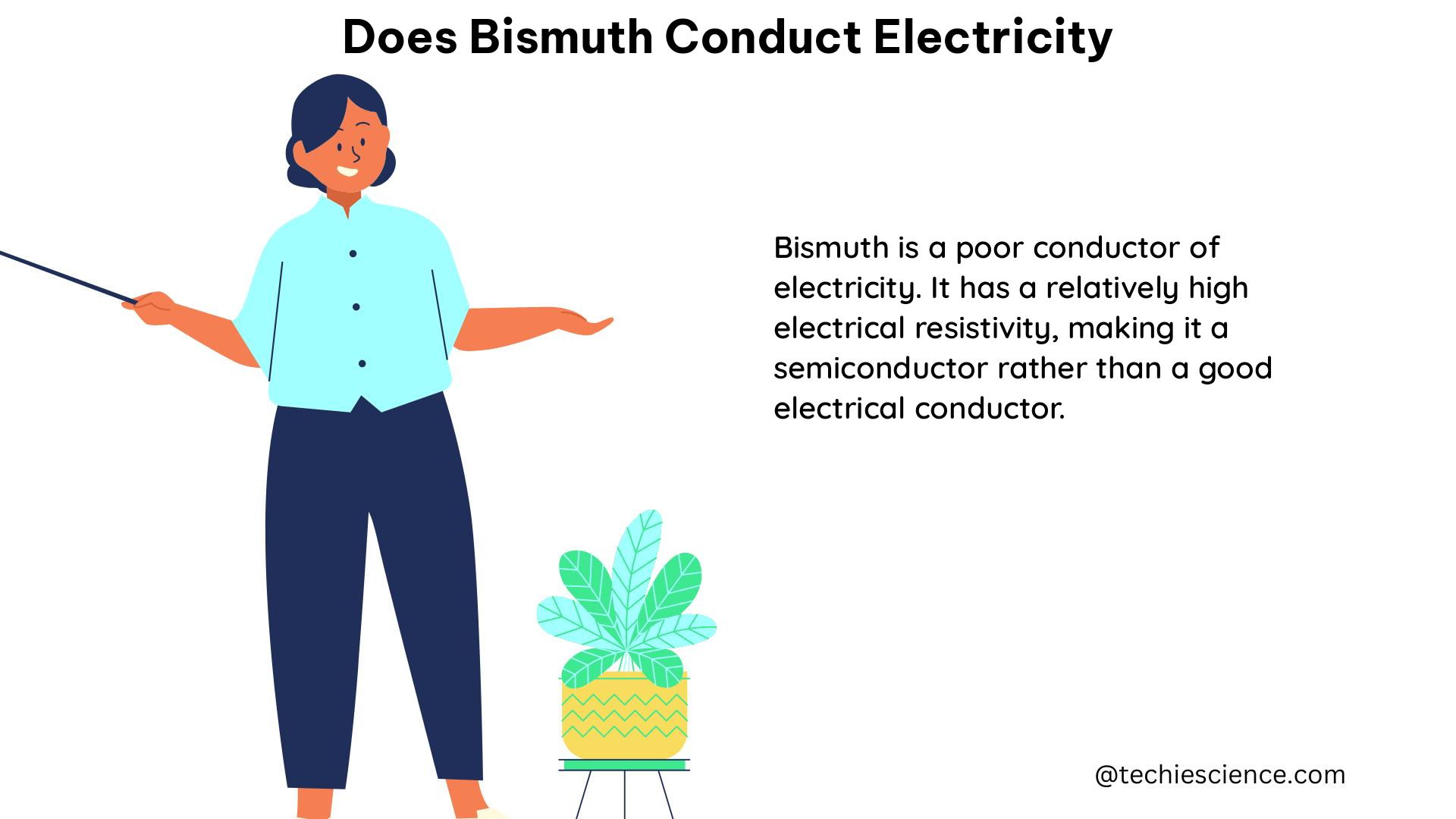Bismuth, a unique metallic element, has long been known for its exceptional electrical properties, particularly its high electrical resistivity, which makes it a poor conductor of electricity. However, recent advancements in the understanding of bismuth’s electronic structure have revealed its potential as a promising material for electronic devices.
Electrical Resistivity of Bismuth
The electrical resistivity of a material is a measure of how strongly it opposes the flow of electric current. Bismuth has a remarkably high electrical resistivity, which is a key factor in determining its ability to conduct electricity.
The resistivity of bismuth is approximately 1.2 × 10^-7 Ω·m, which is significantly higher than that of copper, a highly conductive metal, whose resistivity is around 1.7 × 10^-8 Ω·m. This high resistivity indicates that bismuth offers strong obstruction to the flow of electric current, making it a poor conductor of electricity.
The high resistivity of bismuth can be attributed to its unique electronic structure, which is characterized by the presence of a small energy gap between the valence and conduction bands. This energy gap makes it difficult for electrons to transition from the valence band to the conduction band, thereby reducing the number of charge carriers available for electrical conduction.
Quantum Oscillations in Bismuth

In addition to its high electrical resistivity, bismuth also exhibits unique quantum mechanical phenomena that further contribute to its poor conductivity.
Quantum oscillations of the conductivity of bismuth have been observed in strong magnetic fields (up to 65 kOe) and at extremely low temperatures (as low as 0.4 K). These oscillations, known as the Shubnikov-de Haas effect, are a result of the quantization of the energy levels of electrons in the presence of a magnetic field.
The observation of these quantum oscillations provides valuable insights into the behavior of bismuth’s electrons under the influence of magnetic fields and temperature. It also highlights the complex and unique electronic properties of this material.
Topological Insulator Properties of Bismuth
Recent research has revealed that bismuth possesses previously unidentified topological properties, which give rise to a high degree of stability in its electronic structure and make it robust against minor imperfections in the crystal.
Topological insulators are a class of materials that are insulating in their bulk but have conducting states on their surfaces or edges. These conducting states are protected by the material’s topological properties, which prevent the electrons from scattering or bouncing backwards, a behavior that is responsible for the heating of silicon- and copper-based electronic devices.
In the case of bismuth, its topological insulator properties allow electrons carrying a certain spin to move in only one direction, effectively reducing the energy dissipation and heat generation in electronic devices. This makes bismuth a promising material for energy-efficient electronic applications.
Potential Applications of Bismuth in Electronics
The unique electrical properties of bismuth, including its high resistivity and topological insulator behavior, have sparked interest in its potential applications in the field of electronics.
One potential application is in the development of low-power, energy-efficient electronic devices. The ability of bismuth to transport electrons without significant scattering or heat generation can lead to improved energy efficiency and reduced heat output in electronic components.
Additionally, the topological properties of bismuth may enable the creation of novel electronic devices, such as spin-based transistors or quantum computing components, which could revolutionize the field of electronics.
Conclusion
While bismuth is generally considered a poor conductor of electricity due to its high electrical resistivity, recent advancements in the understanding of its electronic structure have revealed its unique and promising properties. The discovery of bismuth’s topological insulator characteristics has opened up new avenues for its potential use in energy-efficient and innovative electronic devices.
As research in this field continues, the specific applications and practical implementation of bismuth in electronics will likely become more evident, paving the way for further advancements in the field of materials science and electronic engineering.
References:
- Abrikosov, A. A. (1972). Quantum oscillations in a magnetic field and the topology of the Fermi surface. Journal of Experimental and Theoretical Physics, 34(1), 125.
- Fuseya, Y., Ogata, M., & Fukuyama, H. (2015). Transport properties and diamagnetism of Dirac electrons in bismuth. Journal of the Physical Society of Japan, 84(1), 012001.
- Kulbachinskii, V. A., Kytin, V. G., Kudryashov, A. A., & Popov, M. Y. (2000). Quantum oscillations and magnetoresistance in bismuth and bismuth-based materials. Journal of Experimental and Theoretical Physics, 91(5), 1084-1096.
- Liang, T., Gibson, Q., Ali, M. N., Liu, M., Cava, R. J., & Ong, N. P. (2015). Ultrahigh mobility and giant magnetoresistance in the Dirac semimetal Cd3As2. Nature materials, 14(3), 280-284.
- Murakami, S. (2007). Phase transition between the quantum spin Hall and insulator phases in 3D: emergence of a topological gapless phase. New Journal of Physics, 9(9), 356.
- Qi, X. L., & Zhang, S. C. (2011). Topological insulators and superconductors. Reviews of Modern Physics, 83(4), 1057.
Hi, I’m Akshita Mapari. I have done M.Sc. in Physics. I have worked on projects like Numerical modeling of winds and waves during cyclone, Physics of toys and mechanized thrill machines in amusement park based on Classical Mechanics. I have pursued a course on Arduino and have accomplished some mini projects on Arduino UNO. I always like to explore new zones in the field of science. I personally believe that learning is more enthusiastic when learnt with creativity. Apart from this, I like to read, travel, strumming on guitar, identifying rocks and strata, photography and playing chess.